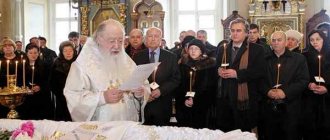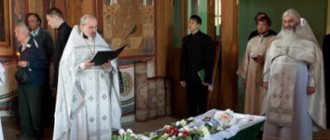"Save me, God!".
Thank you for visiting our website, before you start studying the information, please subscribe to our Orthodox community on Instagram, Lord, Save and Preserve † - https://www.instagram.com/spasi.gospodi/. The community has more than 60,000 subscribers. There are many of us like-minded people and we are growing quickly, we post prayers, sayings of saints, prayer requests, and timely post useful information about holidays and Orthodox events... Subscribe. Guardian Angel to you!
Traditionally, the color of burial clothing is white. He is a symbol of resurrection. When we see that a dead person is lying in a coffin dressed in white, this evokes bright thoughts in all those present and we hope for his resurrection. But mourners should be dressed in mourning clothes, which indicate internal concentration. For the deceased, the shape and color of the robe no longer has any meaning, but the living can show their attitude towards him. But as soon as we learn the terrible news, we immediately begin to sort through the wardrobe of the deceased and make a decision about what clothes men are buried in.
Preparing for the burial of dead people
Deceased people, regardless of age and gender, are usually buried in clothes and in compliance with certain rituals and procedures. First, the body is taken to the morgue, where it is:
- wash (this is done by morgue employees, specially hired people or acquaintances of the deceased, but not related to him, mostly women);
- retouch if there are visible scars on the face and open areas of skin;
- embalmed.
They are buried on the third day after death. For the funeral, they purchase a special mourning set for the coffin and vestments for the deceased, including shoes.
In the old days, the water remaining after washing the deceased was poured into a place where people almost never appear and there is no grass. The same was done with the water in which the dishes were washed after the funeral. The bowl in which the rag used for washing was soaked was broken and thrown away. People believed that in this way they would protect themselves from the return of the deceased from the dead in order to torment their relatives (in the form of a spirit, ghost).
Funeral dress from everyday wardrobe
Funeral: rules or prejudices?
Between these two events lies life.
For one person it is long, for another it is short, but in their lives people, as a rule, drive away the thought of death . But then death , and with it the inevitable bitter worries about burying a person dear to you.
The hours of preparing for a funeral become even more painful if this process is accompanied by a lot of “important advice” about the obligatory “traditions” of a funeral.
Such recommendations are often literally imposed on relatives, making the funeral an unbearable and frightening event.
In fact, most of them are superstitions and prejudices accumulated by humanity over the centuries and have nothing to do with reality.
Here are just a few of these superstitions. However, each person is free to decide for himself what to follow and what not to follow.
- Not often, but it happens that a person thinks about his future death and prepares a coffin for himself in advance. Such a product is usually stored in attics. But here there is a small but very significant “but”: the coffin is empty, and since it is made according to a person’s standards, he begins to “pull” it into himself. And a person, as a rule, dies faster. Previously, to prevent this from happening, sawdust, shavings, and grain were poured into an empty coffin. After the death of a person, sawdust, shavings, and grain were also buried in the hole. After all, if you feed a bird with such grain, it will become sick.
- When a person has died and measurements are taken from him to make a coffin, under no circumstances should the measurement be placed on the bed. It is best to take it out of the house and put it in a coffin during the funeral.
- Be sure to remove all silver objects from the deceased: after all, this is precisely the metal that is used to fight “the unclean.” Therefore, the latter can “disturb” the body of the deceased.
- If there is a dead person in the house, do not do laundry. This must be done after the funeral.
- When the coffin is being made, relatives and friends are prohibited from participating. It is best to bury the shavings formed during the manufacture of the coffin in the ground, or, in extreme cases, throw them into water.
- The bed on which a person died does not need to be thrown away, as many do. Take her and take her out to the chicken coop, let her lie there for three nights, so that, as the legend goes, the rooster will crow her three times.
- When the time comes to place the deceased in a coffin, then they sprinkle holy water on the body of the deceased and his coffin, outside and inside. You can also cover it with incense. The body is then transferred to the coffin. A whisk is placed on the forehead of the deceased. It is given in church when the deceased is brought to the funeral service. The deceased's lips should be closed, his eyes closed, his hands folded crosswise on his chest, the right one on top of the left. A Christian woman’s head is covered with a large scarf that completely covers her hair, and its ends do not need to be tied, but simply folded crosswise. You should not put a tie on a deceased Orthodox Christian. An icon or cross is placed in the left hand of the deceased; for men - the image of the savior, for women - the image of the Mother of God. Or you can do this: in the left hand - a cross, and on the chest of the deceased - a Holy image. A pillow, usually made of cotton wool, is placed under the feet and head of the deceased. The body is covered with a sheet. The coffin is placed in the middle of the room in front of the icons, turning the face of the deceased with his head towards the icons.
- When you see a dead person in a coffin, do not automatically touch your body with your hands. This is due to the fact that in the place where you touched your hand, various skin growths in the form of a tumor can grow.
- If there is a deceased person in the house, then when meeting your friend or relatives there, you should greet with a bow of the head, and not with your voice.
- While the deceased is in the house, the floor should not be swept. If you do not follow this advice, your family members may soon become ill, or worse may happen.
- During the funeral, you cannot visit the graves of relatives and friends located in the same cemetery.
- Do not listen to those people who advise placing two needles crosswise on his lips to preserve the body of a deceased person from decomposition. This will not save the body of the deceased, but the needles that were on his lips will definitely disappear; they are used to cause damage.
- To prevent a heavy smell from coming from the deceased, you can put a bunch of sage on his head; people call it “cornflowers.” It also serves another purpose - to ward off “evil spirits.” For the same purposes, you can use willow branches, which are sacred on Palm Sunday and kept behind the images. These branches can be placed under the deceased.
- A man died, his body was placed in a coffin, but the bed on which he died had not yet been taken out. Friends or strangers may come to you and ask you to lie on this bed. The argument put forward is the following: so that their back and bones do not hurt. Don't listen to them. Don't hurt yourself.
- Do not put
fresh flowers the coffin For this purpose, use artificial ones or, as a last resort, dried ones. - A candle is lit
near the coffin as a sign that the deceased has moved to the realm of light - a better
afterlife
. - A lamp or candle is lit in the house and burns as long as the deceased is in the house.
- Instead of a candlestick, glasses are often used for candles, into which wheat is poured. Some people sprinkle this wheat on others and thereby cause damage. This wheat should also not be used for poultry or livestock feed.
- Make sure that someone else 's things are not placed under the deceased.
If you notice this, then you need to pull them out of the coffin and burn them somewhere away. - It happens that, out of ignorance, some compassionate mothers put photographs of their children in the coffin
of their grandparents. After this, the child began to get sick, and if help was not provided in time, death could occur. - You cannot give your things to dress the deceased
. The deceased is buried, and the one who gave away his things begins to get sick. - A coffin with a deceased person is taken out of the house, and someone stands near the door and starts tying knots in rags. He explains this operation to people by saying that he is tying knots so that no more coffins will be taken out of this house. Although such a person has something completely different on his mind...
- If a pregnant woman goes to a funeral, she will do harm to herself. A sick child may be born. Therefore, try to stay at home during this time, and you need to say goodbye to your loved one in advance - before the funeral.
- When a dead person is being carried to a cemetery, do not cross his path under any circumstances, as various tumors may form on your body. If this happens, then you should take the hand of the deceased, always the right one, and move all your fingers over the tumor and read “Our Father.” This needs to be done three times, after each time spitting over your left shoulder.
- When they carry a dead man in a coffin down the street, try not to look from the window of your apartment or house.
- The ties that bind the hands and feet of the deceased must be untied and placed in the coffin with the deceased. Otherwise, as a rule, they are used to cause damage.
- If you say goodbye to the deceased, try not to step on the towel that is placed in the cemetery near the coffin, so as not to damage yourself.
- If you are afraid of a dead person, grab the dead person's legs and hold on. This can be done before he is placed in the grave.
- Sometimes people can throw earth from a grave in their bosom or collar, proving that this way they can avoid the fear of the dead. Don't believe it - this is done to cause damage.
- Returning from a funeral, it is imperative to dust off your shoes before entering the house, and also hold your hands over the fire of a lit candle. This is done in order to prevent damage to the home.
- The funeral is over, and according to the old Christian custom, water and something from food are placed in a glass on the table to treat the soul of the deceased. Make sure that small children or adults do not inadvertently drink from this glass or eat anything. After such a treat, both adults and children begin to get sick.
- During the wake, according to tradition, a glass of vodka is poured for the deceased. Don't drink it if anyone advises you to.
- There is a dead man on your street, and you urgently need to plant potatoes. Don't waste your time and effort. If you plant potatoes at a time when the deceased has not yet been buried, do not expect a good harvest.
- If you come to the grave of a loved one to pull out grass, paint a fence or plant something, you start digging and dig up things that shouldn’t be there. In this case, everything you found must be taken out of the cemetery and burned. When it burns, try not to get exposed to the smoke, otherwise you may get sick yourself.
- A funeral on New Year's Day is a very bad omen: in the coming year, there will be a funeral at least once a month.
- Sunday's funeral predicts three more funerals throughout the week.
- It is dangerous to postpone a funeral for any reason. Then one, two or three deaths in the family or immediate area will occur within a week or a month.
- If the funeral is postponed until next week, it is probably unlucky, because the dead person will try his best to take someone with him.
- After the funeral, do not visit any of your friends or relatives.
- Viburnum is planted in the heads of the graves of young men and women.
- For the first seven days from the date of death of the deceased, do not take any things out of the house.
- Do not distribute the deceased’s belongings to relatives, friends or acquaintances for up to 40 days.
- If one of you has lost a loved one or loved one, and you often cry for him, then it is advised to have thistle grass in your house.
- When someone dies, try to have only women present.
- If the patient is dying seriously, then for an easier death, remove the feather pillow from under his head. In villages, the dying person is laid on straw.
- To ease the agony of death, the patient must be covered with white material, which will later be used to upholster the coffin.
- When there is a dead person in the house, you cannot drink water in the neighboring houses in the morning that was in buckets or pans. It must be poured out and freshly poured in.
- It is advisable that the washing of the body of the deceased occur during daylight hours - from sunrise to sunset. Water after ablution must be handled very carefully. It is necessary to dig a hole far from the yard, garden and living quarters, where people do not walk, and pour everything, to the last drop, into it and cover it with earth. The fact is that the water in which the deceased was washed causes very strong damage. Therefore, do not give this water to anyone, no matter who approaches you with such a request.
- Try not to spill this water around the apartment so that those living in it do not get sick.
- Pregnant women should not wash the deceased in order to avoid illness of the unborn child, as well as women who are menstruating.
- As a rule, only elderly women prepare the deceased for his last journey.
- The shroud must be sewn on a live thread and always with a needle from yourself, so that there are no more deaths in the house.
- In the house where the dying person lay, all the keys were removed from the keyholes and the doors and windows were opened so that the person’s soul could leave the body without interference. When a person gave his soul to God, he was necessarily washed so that he would appear before the Lord pure in soul and body.
- Strict rules were followed when washing the deceased. The deceased was placed with his feet next to the stove and washed 2-3 times with warm water and soap from a new clay pot. The water with which the deceased was washed became “dead”, and it was poured somewhere far away so that a healthy person would not step on this place, and also so that the sorcerer would not take it for himself to cause damage. The same was done with the water used to wash the dishes after the funeral and the floors after removing the deceased from the house. They also tried to get rid of other attributes of ablution as quickly as possible.
- In the coffin of the deceased they place his baptismal cross, a small icon, a crown on his forehead, candles and a “handwriting” - a written prayer for the remission of sins. They give a towel (scarf) in their hands so that the deceased can wipe the sweat from their face during the Last Judgment. Who died on Easter - an egg in his hand.
- The deceased is usually buried in white clothes, personifying the infantile purity of the Christian soul.
- A sign was strictly observed: do not make the coffin larger than the deceased, otherwise there will be another deceased. In the house, as a sign of mourning, mirrors are curtained or turned “facing” the wall so that the person’s soul does not remain locked on the other side of the mirror. All clocks are also stopped as a sign that a person’s life journey has been completed. Before the funeral, friends and relatives come to say goodbye to the person, but 20 minutes before the removal of the body, only the closest relatives should remain with the deceased.
- Take the dead person's dirty linen out of the house - take everyone out of the house.
- In preparation for removing the body, first they take wreaths and a portrait of the deceased out of the house, then the lid of the coffin (with the narrow part forward), and finally the coffin itself (the deceased is carried out feet first). At the same time, thresholds and doorposts should not be touched so that the deceased is not tempted to return home.
- “The dead man is alone in the house,” they say as they take him out and lock him in the house for the time being. According to the old tradition, the deceased should not be carried out before noon and after sunset, so that the setting sun could “take” the deceased with it. Relatives should not carry the coffin so that the deceased does not take a blood relative with him to the grave.
- After removing the coffin from the house, be sure to wash all the floors (previously they washed not only the floors, but the whole house with water).
- The path of the funeral procession to the cemetery is covered with spruce branches, which serve as a talisman, a guarantee that the deceased will not “walk” and will not retrace his steps.
- At funerals, it is customary to present those present with pies, sweets, and handkerchiefs. This is nothing more than the distribution of alms, which obliges those who accept it to pray for the deceased. In this case, those praying take on part of the sins of the deceased.
- When you come home after a funeral, you need to warm your hands so as not to bring the cold of the grave into the house. After the funeral, no intoxicating drinks are allowed in the mouth for 40 days. At funerals, they drink only vodka, and those who come are always fed pancakes and kutya.
- For the soul of the deceased, a glass of vodka, covered with a slice of bread, is placed on the table. It must stand for 40 days, until the person’s soul has completely left this world.
- They don’t stay long at wakes. For six weeks after the funeral, there should be a glass of water on the windowsill, and a towel should hang on the corner of the house, outside the window, so that the soul can bathe and dry itself before the funeral. On the fortieth day, the soul of the deceased comes to his home for the whole day and leaves only after the so-called farewell. If they are not arranged, the deceased will suffer. Six weeks after death, “ladders” of dough are baked to help the soul climb to heaven. According to Russian tradition, in the folk month there are special days on which Orthodox Christians commemorate those who moved to another world.
Some features of the selection of funeral clothing
Clothing for a funeral ceremony is chosen based on existing traditions and the wishes of the deceased, voiced before death. It should be remembered that:
- It is customary for men to be buried in suits (a suit is the only thing that Orthodox Christians bury men in);
- women are buried in a dress or suit consisting of a skirt, blouse and jacket;
- clothes are chosen in discreet dark shades;
- The woman’s head must be tied with a blue or dark green scarf (this will help hide the blueness of her face);
- a suitable kit can be purchased at the funeral home;
- shoes are chosen one size larger than what the deceased wore during his lifetime;
- clothing must be appropriate for the season (in winter they are buried in warm clothes);
- clothes should fit in size, but if they are small or uncomfortable, then they can be cut at the back, it will not be visible (it is better to choose clothes even a little larger);
- all things must be new, an exception is made for cases when they want to bury the deceased in their favorite clothes or uniform;
- You can’t put a deceased person in the thunder, dressed in clothes from someone else’s shoulder, especially in the clothes of close relatives.
Clothing for a funeral for a woman or a man is traditionally black, dark blue or brown. But sometimes they are buried in what the deceased chose for himself before death. This could be your favorite floral dress or a pink wedding suit. In the West they take this calmly. But if the burial ceremony is accompanied by a funeral service, then before choosing clothes for the funeral, a priest is consulted.
Woman's headdress for a funeral
How to dress a dead woman
Women's funeral attire consists of:
- a skirt covering the knees in a dark shade;
- blue or green blouses;
- jacket to match the skirt;
- dark stockings or tights;
- underwear (some funeral agencies dress you in pantaloons and a nightgown);
- hard-soled slippers or flat shoes;
- a scarf on the head (the scarf should cover the hair, its ends cross under the jawline, without tying).
Clothes should not be decorated in any way; beads, rhinestones and even embroidery are not welcome. If necessary, if relatives do not know what to bury an elderly woman in, whose clothes, previously purchased for a funeral, have suddenly become too small, she is placed in a coffin in a shroud (funeral clothing). The suit on the list can be replaced with a dress with a shallow neckline. The neckline must be covered, and the jacket or blouse must have long sleeves.
An example of clothing for a woman's burial
Is it possible to bury a woman in trousers?
Not knowing what a woman is buried in, many try to purchase pantsuits for the ceremony so as not to bother with stockings. But burying a woman in trousers is undesirable. This is contrary to custom, which is why it is the dress or skirt suit that relatives most often choose to dress the deceased. Sometimes women are buried in light-colored dresses and suits, but usually light-colored clothing can only be seen on young deceased women.
Why unmarried girls are buried in a wedding dress, 3 reasons
Girls who did not have time to be married, but have already left infancy, are buried in a wedding dress or in an ordinary light dress. The custom of burying young people in wedding attire arose a long time ago and is associated with:
- white, as a symbol of innocence (the girl is handed over to Jesus Christ and becomes his bride);
- the fact that the soul of a deceased woman who has never been married is supposedly doomed to eternal wandering between the world of the dead and the living, which is dangerous for the latter (the ancient Slavs performed a ritual during funerals similar to the wedding ceremony and thereby protected themselves from a kind of revenge of the restless soul);
- fulfilling the deceased's dream of one day becoming a bride.
The deceased is not just dressed in a wedding dress, but also in all the attributes appropriate for the occasion - a wreath, shoes, a veil. In the villages they bake special “wedding” loaves, and previously they also chose a funeral groom, dressing the tree in a wedding wreath, which they then threw into the grave.
Clothes for single women
How to conduct a wake on the day of a funeral
A funeral meal is not obligatory, but it is customary to have one on the day of burial. For the wake, you can set the table at home or go to a cafe. It all depends on the budget and the number of people present. Just before this you should come to the cafe and reserve a separate room or some part of the hall. Other visitors to the cafe are not in mourning, and they will not feel comfortable participating in the wake. To avoid awkward situations, it is better to rent a cafe for a few hours. If you're on a tight budget, you can host a funeral meal at home. Funerals also take place on the third, ninth and fortieth day.
What clothes do men bury in?
The only thing that men are buried in, clothing during whose lifetime already rarely occupied a special position, is a suit. Mandatory attributes of a funeral kit are also:
- slippers;
- shirt;
- underwear;
- socks.
A tie, cufflinks or belt are not placed in the coffin along with the deceased, since it is generally not customary to tie anything. If a woman’s outfit has a belt (on a dress, for example), then it is not tied, folded crosswise on the lower back. Do the same with a scarf. An exception is made for men who during their lifetime could not imagine themselves without a tie or belt. In this case, it is permissible to tie a tie and wear a belt in your trousers. Cufflinks, like any other jewelry, are still rejected. And yet, how deceased men are dressed before the funeral is decided by relatives. If mom or brother likes cufflinks and other accessories, they are placed in the coffin.
Where can I get a death certificate?
A death certificate is issued at the territorial registry office. If there are several registry offices in the city, you need to look at which organization the deceased belonged to according to registration. You must bring a death certificate to the registry office. On its basis, the representatives of the deceased will be issued a death certificate with an official seal. This certificate cannot be laminated and should not be folded. It's better to make several copies, because... they will be needed in the further organization of the funeral of the deceased. Along with the certificate, a certificate is issued to receive a funeral benefit. You can also issue a certificate at the MFC (multifunctional).
A death certificate is an important document that will be needed in preparation for burial. Without this document, a funeral cannot be held, since it is confirmation that the person really died. Also, the testimony is proof that under the guise of one person they are not trying to bury another. You must have this paper with you on the day of burial.
What are Kazakhs buried in and how?
Preparing the body of a deceased Kazakh for burial begins with washing. Moreover, if the deceased was a man, then this task is entrusted to male persons; women are washed by women. The tools used for washing are buried near the grave. Kazakhs who profess Islam are dressed in:
- akyret (there are female and male versions of this national funeral costume - a shroud, the male one consists of 3 parts, and for women - 5);
- turban if a man died.
For akyret, a thick white cloth is needed, which is used to wrap the body and legs. A man's turban is made from the same fabric. The deceased, previously dressed in akyret, was also wrapped in a carpet, bandaged in three places. Now they can wrap me in felt. The ritual of placing the body in a shroud and sewing it is entrusted to the mullah. After reading all the necessary prayers over the body and performing rituals:
- distribute all the clothes of the deceased;
- they carry the body out of the house head first;
- they place the deceased on a wooden board and read a special prayer over him - zhanaza (only men are present at it);
- they carry the body to the cemetery, carrying it feet first.
During the burial of Muslims, only men are present; women at this time remain at home and perform the required rituals.
Burial of Kazakhs
Muslim traditions
Muslim funerals are significantly different from Orthodox ones, and this is understandable, there is a great difference in culture. The main feature is the presence of a snow-white caftan or shroud , which plays the role of a funeral robe. The quantity and quality of fabric must correspond to the status of the deceased person.
- A man's funeral suit consists of three sections: “lifofa”, “izor”, “kamis”. Each piece of linen covers and wraps a specific side of the body.
- The shroud for women has the same parts as for men, but it additionally requires a headdress (usually a scarf) and a “khimora” that hides the chest.
What are the Chinese buried in?
Traditionally, Chinese people are buried in white robes. Relatives and friends also come to the cemetery in white clothes and bring white flowers with them. This is what they did in ancient times. Nowadays, any clothes except red are used for funerals. This color is considered a symbol of life, therefore it is not used during burial, temporarily removing all objects of a red hue from the house.
Residents of China mortify the dead or burn the bodies in the crematorium. At the same time, it is extremely important that as many people as possible come to the funeral; to attract those who wish, relatives send out special invitations to everyone they know; they can bury or burn their favorite things with the deceased. It is believed that he will be able to use them in the afterlife.
Chinese burial ceremony
What do they dress a man in?
Some traditions of dressing the deceased date back almost to the time of the Scythians. As we have already mentioned, it is customary for a person who was a military man (with the exception of a retiree), a policeman or a firefighter during his lifetime, to be buried in full uniform, and front-line soldiers often ask to be buried not only in it, but also along with their awards. This is a remnant of the oldest tradition of military funerals that has survived to this day. As you know, it was customary to bury the dead or deceased warriors of the princely squad and the prince/leader himself in full combat gear and always with their weapons, and they had to fulfill the same role in the afterlife that they performed during the life of their owner. That is, in the understanding of the pagan Slav, weapons were first of all an object of necessity and only then an indicator of the lifetime status of the deceased. Such traditions were characteristic of many ancient peoples at different stages of development, and the Slavs in this sense were no exception. In this regard, the role of awards in which front-line soldiers ask to be buried is interesting. Considering the symbolism of many details of funeral clothing, it can be assumed that the awards are a subconscious replacement for the weapon and at the same time the result of its service to its owner, as well as an indicator of the valor shown by him on the battlefield. The Church is generally tolerant of such requests and traditions - at least in no source have we encountered any outright rejection of them by clergy. The only requirement that can be seen concerns the color scheme of men's funeral clothing: it should be discreet, preferably dark tones or black.
A civilian's clothing set should include:
- underwear.
- socks.
- shirt.
- blazer.
- trousers.
- shoes, if possible – without heels. For an elderly person, slippers without hard soles are acceptable.
Opposing opinions can be found regarding whether or not a tie and belt should be worn on the deceased. Some sources classify a tie as a desirable but optional accessory for the deceased’s clothing, but leave this to the discretion of loved ones. Some are guided by the tastes of the deceased during his lifetime: they say, if he loved and wore ties, then it would be logical if the tie became part of the funeral clothes. As for the waist belt, the appropriateness of its use is also left to the discretion of the people involved in the funeral and dressing of the deceased, especially since it is not visible under clothing. On the other hand, one can come across a statement with reference to the Psalter that Christian customs categorically prohibit putting a tie and belt on the deceased - they say, this means subjecting him to posthumous torment. It is difficult to say who is right in this case, so it would probably be best to consult a priest.
What and how are homeless people buried?
Homeless people do not have a specific place of residence, and in most cases nothing is known about their relatives. The burial is handled by the state, allocating funds from the local budget. There is no funeral ceremony as such. The body is taken to the morgue by the police. It remains there until the autopsy and cause of death are determined. After the allotted time, the deceased is placed in a burial bag or in a simple coffin and buried in the nearest cemetery. There is a special place for these purposes.
It is impossible to cremate homeless people; there is always a possibility that after some time the relatives of the deceased will be found and they will want to visit the grave, conduct a church ceremony, or the circumstances of the death will become clear that may be of interest to the police. Everything is very complicated, homeless people die not at home, but on the street, the cause of death is quite easy to establish - cold, alcohol consumption. But sometimes, some time after death, it is also possible to find out why the person ended up on the street and what alcoholic drinks he drank. The perpetrators of the incident are found, the police have to conduct a second autopsy.
How to bury a person: the procedure for mandatory actions
After resolving issues with the morgue, you need to buy a coffin, find a burial place and agree on transporting the body from the morgue. The cemetery is selected taking into account the registration of the deceased, but you can agree on burial in some special place. But then you will have to come to the cemetery in advance, find the administration and resolve the issue officially or unofficially.
You will also need to order a hearse. The coffin cannot be transported in ordinary cars or trucks. This ban is regulated by the law on burial, so morgue employees may not release the body until they are sure that the relatives have a hearse.
You need to make an appointment at the cemetery at least 24 hours before the day of burial. You should bring your death certificate with a stamp. If the body is buried in a burial plot that already contains the graves of relatives, then a certificate will need to be presented for it. The document identifies the person responsible for this grave.
If the responsible person cannot be present now, the organizer must present a notarized power of attorney for the right to use this site. If this is also impossible, then you must prove your relationship to those who are buried on the site.
If necessary, the body can be buried in an existing grave. According to sanitary standards, burial of a coffin on a coffin is allowed if 15 years have passed. An urn containing ashes can be placed in the grave at any time. The gender of the deceased does not matter. A man's coffin can be placed in a woman's grave and vice versa.
At the cemetery you will have to pay for:
- digging a grave (prices differ in winter and summer, but if it starts to rain during the burial, the cost usually does not increase);
- formation of a burial mound;
- placing the coffin in the grave;
- restoration of soil shrinkage;
- carrying the coffin from the hearse to the grave site;
- dismantling the flower bed and monument (if the burial is in an existing grave);
- removal of trees from the site, etc.
What is forbidden to wear on the dead?
No one will judge the relatives if they dress the deceased in clean, but already worn, clothes. The color of the suit, fabric and texture also do not play a role in most cases. But there are some features here:
- A negative attitude towards the color red, the answer to the question of whether one can be buried in a red dress is negative. In ancient times, brides were dressed in red, while white was the color of mourning. Now many people believe that this is the color of blood, which has no place at a funeral. Exceptions are made only for those people who adored red during their lifetime. It’s interesting that in China, scarlet is a symbol of all living things, so the dead there are also not buried in red. Ceremony directors, if invited, know exactly what is needed for a funeral for a woman and a man. The clergyman will help you not to make a mistake with the choice of clothes.
- Beads, necklaces, rings and expensive earrings have no place in a coffin. The soul cannot take anything with it on its final journey, so jewelry placed in the coffin is more likely to attract looters than to help in the Heavenly world. Everything is removed from the deceased, including the wedding ring, if the second spouse is still alive. This is important, the soul of the deceased, with whom the wedding ring was buried, will not be able to rest, and over time it will drag the spouse along with it (Orthodoxy and paganism agree on this).
You cannot dress a deceased relative in the clothes of a close relative, be it a scarf or tights. Old things are things that are not buried in.
Can funerals be held free of charge?
If the relatives of the deceased refuse to receive funeral benefits, they can count on a free social funeral. In case of a free funeral, the relatives of the deceased are provided with:
- wooden coffin with fabric upholstery;
- funeral veil;
- white slippers;
- one-way hearse to the cemetery or crematorium.
The administration also covers the cost of digging the grave and burial services. If relatives decide not to bury the body, but to cremate it, cremation can also be paid for from budget funds. All other services and ritual attributes will have to be paid for independently. But even if costs are reimbursed, you will have to organize the work of cemetery and morgue employees yourself.
Also, the funeral will be paid for from the state budget if the person died while serving in hot spots, as a result of a terrorist attack, due to any high-profile events, etc. The relatives of the deceased are usually informed about this immediately.
Where to buy clothes for a funeral
Special clothes for burial in Russia are offered for sale by funeral homes. If the deceased was a large or, on the contrary, a miniature person, then finding a suitable set will not be easy. As an option, contact the studio. Clothes should not be tight, it is better to take a size larger, all folds can be easily hidden. A simple dark skirt and blouse is definitely something that would not be embarrassing to bury an elderly woman in.
A ready-made funeral suit will cost more than a regular suit purchased in a store. But buying it has its advantages, one of which is that you can choose clothes of the size that is needed. Not all relatives have the strength and desire to take body measurements in order to go to the store with them and try to purchase everything they need. Many people do not know what young women, grandparents and children are buried in.
How to properly apply for a funeral benefit
A funeral benefit is a government subsidy given to those who have taken on the responsibility of arranging the burial. The procedure for obtaining funeral benefits is reflected in detail in the legislation. To receive this money you should contact:
- at the place of work of the deceased with the management of the company (if the deceased was officially registered);
- to the Pension Fund (if the deceased was a pensioner and received a pension);
- in Social Security (if the deceased did not work and was officially registered as unemployed);
- to the military registration and enlistment office (if the deceased was an active military man or veteran).
The list of documents required for registration and the sequence of their submission can be clarified with the organization. Money can be issued in cash or transferred to a specified account. This benefit is not income and you do not have to pay tax on it. But receiving this benefit is a right, not an obligation. Those. Without a statement from relatives, this money will not be credited automatically.
Who should dress the deceased?
The morgue staff will dress the deceased if you first bring them a suitable set. But this can also be done by relatives or friends. In the old days, only women, elderly or unmarried, had to dress the deceased; the same rule applied to washing the body. Now this is no longer a ritual, but an ordinary everyday process that can be entrusted even to a stranger for a fee.
Seeing off the deceased on his last journey, the relatives understand that they will never see him again in this life. But many people don’t know anything about funerals, what they bury people in, or how it’s done. It is important to bury the body as it should be, with maximum observance of all required rituals. Particular attention is paid to the funeral set and clothing in which the deceased is planned to be placed in the coffin. Men are buried in dark suits, women in dresses or skirt suits. The color and texture of clothing depend on the age of the deceased and his preferences during life.
What to do if a relative dies
The death of a person is a sad event, but it requires clear and understandable actions. If a relative has died, it is necessary to prepare the documents correctly so that no problems arise with the burial in the future. A person’s funeral can take place in any region, regardless of the official registration of the deceased.
Death at home
If a loved one died at home, then you need to call 02 or 03. Further actions depend on the exact reason for which the person died. If the death is criminal in nature, law enforcement officers will be at the scene.
The police officer on the spot draws up a protocol for examining the body of the deceased and takes a brief explanation from those present. If the deceased was ill for a long time, this must be reflected in the protocol. It is with the preparation of this document that the organization of the funeral should begin. One copy of the protocol must be left with the relatives of the deceased. This document must be given to the orderlies of the corpse transport.
If a person died of natural causes, he will be taken to the morgue almost immediately. Anyone can call the police and doctors. Relationships are not required. In addition to the ambulance service, you can invite a local doctor during working hours.
The attending physician can give step-by-step advice on what relatives need to do. For example, if your grandmother died of cancer, you need to carefully close all the windows in the room in which the body lies. If the oxygen supply is not reduced, unpleasant black spots begin to appear on the deceased. If the deceased suffered from tuberculosis, then it is necessary to thoroughly clean the sofa or bed where he slept. But it is better to throw away many household items to exclude the possibility of getting the tuberculosis bacillus.
Each clinic is assigned to a specific morgue. If the deceased was observed in a certain medical institution, then a corpse transporter controlled by this particular organization should be called. But according to the law, relatives can refuse a state corpse transport and call a private one so that the deceased can be taken to a specific morgue.
Corpse truck employees take the protocol and the document issued by the doctors, which confirms the death of the person. The passport and other documents of the deceased (licence, medical insurance, SNILS) remain with his relatives.
Funeral agents often arrive after the corpse truck and ambulance and offer their services. If a person does not know exactly what to do with a funeral, he can use their services. But first you should clarify the cost of their work, the list of services and the legality of their activities.
If the deceased bequeathed his body to any medical organization during his lifetime, he should contact them and report what happened.
Death in hospital
In hospitals, deceased patients are also taken to the morgue, regardless of where they died: in the operating room, in intensive care, or in a regular ward. Relatives are informed about the incident almost immediately.
All these actions allow you to document the fact of death. Then the relatives or friends of the deceased will be given a death certificate. This certificate is necessary for issuing a death certificate, so you should definitely obtain it.
People who die in a hospital are buried in the same way as those who die at home. The exception is criminal deaths. If an undocumented patient is brought to the hospital and dies in a medical facility, and he remains unidentified, he is also buried if no one comes to claim the body.
Receiving an epicrisis
To obtain a death certificate and a proper funeral for a person, you will need an epicrisis from the clinic. The epicrisis is drawn up by the head of the clinic. This document briefly describes the medical history of the deceased and a list of pathologies from which he suffered. Based on the epicrisis, a post-mortem diagnosis is established. Without an epicrisis, the corpse will be autopsied. Such an autopsy is also necessary in order to exclude a criminal version of the death of a person.
Documents for the church
If the deceased will be buried according to Christian traditions, it is necessary to take a duplicate certificate of the cause of death for the priest. This document will certify that the person died a natural death and did not commit suicide.











